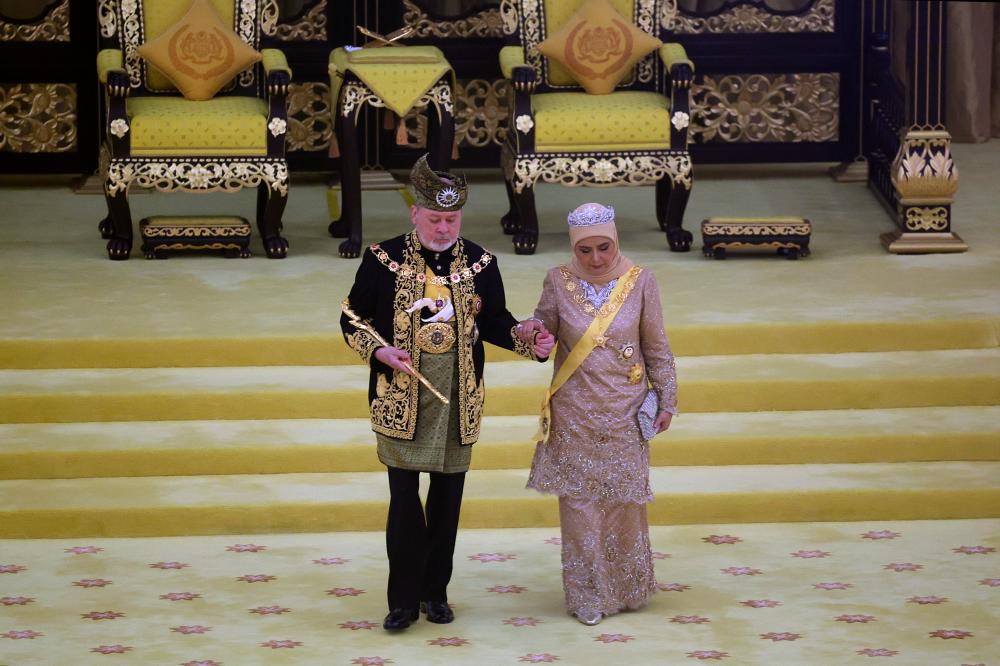KUALA LUMPUR: Her Majesty Raja Zarith Sofiah, the Queen of Malaysia, exuded regal beauty and royal authority in a Kurung Johor outfit adorned with the golden hibiscus motif embroidery at the Installation Ceremony of His Majesty Sultan Ibrahim, the 17th King of Malaysia at Istana Negara today.
According to the designer and renowned fashion creator Datuk Radzuan Radziwill, the hand embroidery depicting hibiscus and ‘awan larat’ motifs adorning the Queen’s attire were inspired by the King’s ceremonial ‘Muskat’.
The Kuala Kangsar native, said the national flower embroidery, was sewn onto gold-coloured lace and lined with taffeta of the same hue, communicating Her Majesty’s indisputable elegance.
“We emphasise traditional elements in the design of the Queen’s Baju Kurung Johor, with the Teluk Belanga neckline, which is more modest. However, we made slight modifications for easier wearing of the sash, orders, and medals,” he told Bernama recently.
Radzuan said he received the order from Raja Zarith Sofiah to design the attire for the installation ceremony, including the headcovers and other accessories, three months before today’s ceremony, adding that the Queen expressed her ideas to be incorporated into the design.
The fashion designer said the Queen also chose all the colours and fabrics to produce the outfits for the event, which helped him in the designing process.
“We came up with three to four sketches for each outfit, and from there, we made necessary adjustments based on the Queen’s feedback,” he said.
Elaborating, Radzuan said after several fitting sessions with Her Majesty, they discovered it took more than two hours for the Queen to don the complete set.
He also mentioned that to maintain the position of the orders and medals on Raja Zarith Sofiah’s attire throughout the ceremony, he used a unique ‘framing’ technique.
“It is our secret technique to ensure the orders and medals stay in place. It is a technique created through experience. The ceremony involved movements, so we had to be meticulous. Images from the ceremony stay forever, and we want our creations to look the best,” he said.
Asked about the size of the team that handled the Queen’s ensemble, Radzuan said about 30 people were involved in coming up with the sketches and designs, making the patterns, cutting the fabrics, sewing and embroidery, among other things.
He said that because of thorough planning, the team only worked on the outfits during regular working hours, from 8 am to 6 pm, but still managed to finish the project on time.
“Within the three months, we completed three outfits for Raja Zarith Sofiah: one for the installation ceremony, one for the Royal Banquet, and another to be worn during His Majesty’s official visit. Alhamdulillah, we managed to finish,” he said, noting that the team also created the Queen’s attire for the official portraits.
Radzuan, who has over 30 years of experience in the fashion industry, placed great importance on detail and techniques in creating the Queen’s outfits, especially in the embroidery, the primary focus of his designs.
“I was nervous but also excited. We could not afford to be careless because it was the attire to be worn by the Queen. I will remember this experience forever,” he added.
Malaysia witnessed the installation of Sultan Ibrahim as the 17th King of Malaysia, a formal proclamation that His Majesty has ascended the throne as the Supreme Head of the Nation.
Approximately 700 guests attended the installation ceremony, including the Malay rulers, governors, Prime Minister Datuk Seri Anwar Ibrahim, Cabinet ministers, as well as foreign leaders and dignitaries.
Sultan Ibrahim was elected the 17th King of Malaysia at the special 263rd meeting of the Conference of Rulers, at Istana Negara, on Oct 27, 2023 and took the oath of office to reign as the 17th King of Malaysia for the next five years on Jan 31.









